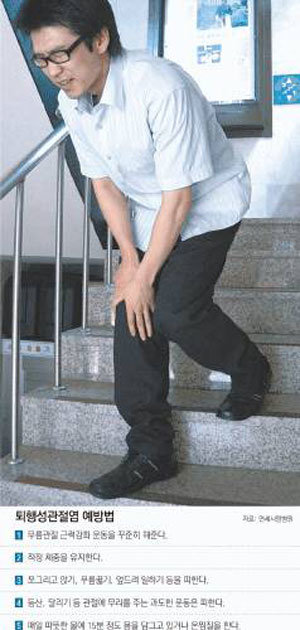Dont Neglect Your Joint Problem

Office worker Hong Hyeong-cheol (29, resident of Seocho, southern Seoul) hurt his right knee while playing soccer a year ago. Experiencing severe pain and swelling of the knee, he went to an oriental medicine clinic for acupuncture. Hong thought he was cured. But the pain soon recurred every time he exercised or went hiking. Eventually, he went to see a doctor and belatedly realized that he had to undergo surgery for the damaged cartilage in his knee joint. The operation would have been unnecessary if he did not ignore the persistent pain.
The joint disease, which is known as an old-age or geriatric disease, is fast spreading among young people. According to Yonsei Sarang Hospital, which analyzed 71,012 patients who received medical treatments due to knee joint disorder between 2005 and 2007, the number of knee joint patients among people in their 20s and 30s jumped from 2,376 in 2005 to 5,800 in 2007. The number of teenage patients also dramatically increased from 690 to 1,359 during the same period.
Experts believe that the rapidly swelling number of joint patients can be attributed to increased leisure and sport activities in society.
As many young people do not consider knee pain as a serious problem, they tend to leave it as it is and think that it will be healed if they take a little rest, said Goh Yong-gon, director of the Gangnam branch of Yonsei Sarang Hospital. However, negligence will cause inflammation and the destruction of bones, making young people also suffer from a degenerative joint disease.
○ Exercise may damage cartilage disc
Knee pain can be caused by trauma from impact and excessive use of the joint. Some 70 percent of young people experience pain while playing intensive sports, such as soccer, basketball and marathon. The most common cause is severe impact which tears crescent cartilage disc, a durable chip bone that functions as a cushion between the lower and upper bones of the knee joint.
The cartilage disc is also gradually damaged by repeatedly doing less-intensive exercises, such as aerobics, jogging and hiking. If the damaged disc is unattended for a long period time, it can cause a degenerative joint disease.
If the cartilage disc is torn or worn out, the impact is delivered to the bone as it is. Experiments on animals showed that removing 20 to 30 percent of the cartilage disc increased the stress on the knee joint 3.5 times.
If you feel pain in the knee during exercise, you should go to hospital immediately as you are likely to have already damaged a certain degree of the cartilage disc.
The followings are the symptoms that you should go see a doctor for: Pain in the knee while walking or going up and down the stairs; a sudden piercing pain; a snapping sound in the knee; and persistent pain even after a rest or physical therapy.
○ Arthroscopy, a minimal surgical procedure
It is difficult to identify damage in muscles, ligaments and, in particular, cartilages by X-rays. The MRI (magnetic resonance imaging) test or arthroscopy is recommended to diagnose a degenerative joint disease.
Though the MRI allows us to clearly identify the knee structure and muscles around the knee and ligaments, it has only an 80 percent chance of finding damage in the cartilage disc, says Kim Yong-chan, director of the Bucheon branch of Yonsei Sarang Hospital. If you employ arthroscopy, which allows us to see it with our own eyes, it is easy to identify damage in ligaments or the crescent cartilage disc.
An arthroscope, which is equipped with a micro camera, is similar to a gastrofiberscope. In an anthroscopic examination, a surgeon makes a small incision around the patients joint and inserts an arthroscope, which is approximately 2 millimeters in diameter. Arthroscopy allows removing the damaged cartilage disc with a precision, but the downside is that it requires anesthesia.
Arthroscopy is recommended in the following cases: If the pain continues when the X-ray and a detailed test have no abnormal findings; when excess fluid continues to accumulate in or around the knee joint; if you feel pain or dislocation from inside of the knee when sitting Indian style; when the back of the knee becomes numb or hard to stretch; and if you feel pain or fatigue after a knee injury when taking a walk.
○ Severe cartilage damage treated by grafting cultivated cartilage
If the cartilage damage is not serious, the condition can improve with medication and intrarticular injection. However, if the degree of the cartilage damage is serious, an operation is necessary.
A common surgical treatment is the cartilage regeneration operation. If the size of the damage is very small, the micro-drilling method can also be considered. The drilling method cures the injury by making a tiny hole that helps cartilage stem cells discharged to the damaged area.
If the size of the cartilage damage is smaller than 2 centimeters, autografting of cartilage should be done. Cartilage from a part of your own knee that receives pressure is taken for the grafting.
If the size of the cartilage damage is bigger than 2 centimeters, grafting cultivated cartilage is recommended. As your own cartilage is taken and cultivated, the surgery does not have the risk of rejection, and the survival rate of cartilage cells is more than 90 percent.
Once cartilage is damaged, it cannot be cured naturally or regenerated. Therefore, prevention is important.
likeday@donga.com







